SPRINGTOWN FARMDEN, INT’L HEALTH SPA
“Ancient Japanese” Exercise(?)
Welcome to Springtown Farmden, the international health spa. Allow me to show you around for a tour of our exercise offerings. The techniques and equipment used come from all reaches of the world (or at least can sound like they do).
The first couple that can get your blood pumping “come from” across the Pacific, Japan. The first of these, sīth-ing (translation: scything), does require development of some technique and access our more specialized equipment, a sīth (translation: scythe).
The sīth has a single pole with two handles attached, one at the upper end and one about halfway down. The metal weight attached at the bottom of the sīth is a couple of feet long, curved, and sharpened on its inside edge. Muscle tone and strength is created by putting the left hand on the upper handle, the right hand on the lower handle, flexing the spine to the right and then unwinding yourself counterclockwise while trailing the metal weight just above ground level. (The best of these sīths come from Austria, but are available in the US here.)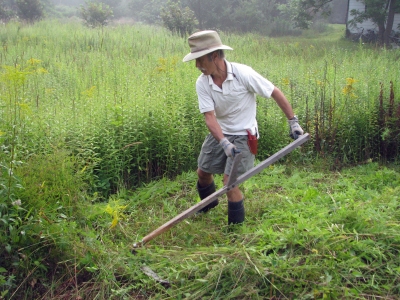
Sīth-ing can be made more rigorous by passing the sharp metal through tall grass or meadow plants. The taller the plants, the denser the plants, and the older the plants, the more the resistance.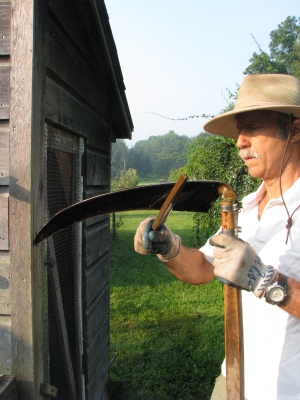
A side benefit of all this sīth-ing is that grass or meadow plants get mown during the exercise. The fallen material drops right in place, providing opportunity for the next trans-Pacific exercise: Rei-king (translation: raking).
Equipment for rei-king is a pole, perpendicular to and at the end of which is a length of wood or metal, attached in its middle to the pole. From the lower side of the length of wood or metal are teeth, each a couple of inches apart and a couple of inches long.
Now for the exercise. You lift the pole just enough to bring the head off the ground, reach forward, and pull it towards you. For balanced exercise, it’s advised to occasionally switch which arm is most forward.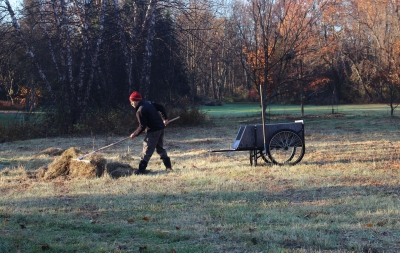
Resistance is the way to build up muscle and endurance. That resistance comes in the form of friction from material lying on the ground.
By the way, either exercise is most enjoyable early in the morning. At that time, plants are turgid so the sharpened metal of the sīth pops plant cells as it is drawn along. And the fallen plants, best for rei-king after lying on the ground a day or two to wilt, cling together nicely when heavy with dew. The cool morning air is also conducive to exercise.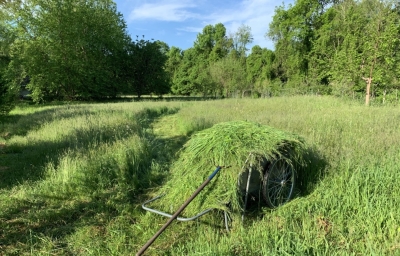
And From India(?)
Let’s now travel further west (or so it seems), to India, for yōgdening (translation: garden yoga).
Yōgdening grew out of my respect for the soil, my desire to maintain and foster a healthy balance of life below ground by neither compacting nor tilling the soil.
Compaction is avoided because no one is allowed to walk, roll a wheel barrow, or in any other way traffic where plants are growing. Vegetable beds, for instance.
Tillage burns up valuable organic matter. But organic matter feeds and maintains beneficial soil microorganisms as well as improves soil drainage and aeration. After all, plants in fields and forest grow well despite never being tilled except what earthworms and other small animals manage to do. And those earthworms do work hard: Charles Darwin computed that earthworms completely turn over the upper six inches of a pasture soil every 10 to 20 years — in England, at least.)
Getting back to yōgdening . . . Weeds continually attempt inroads into my plantings. The only way to reach some of these areas, a bed of various flowers sprawling beneath some Asian pear espaliers, for example, is by gingerly stepping into them. To minimize foot traffic, after stepping into a planted area, I try to keep my foot anchored in just one place, from which I pull every weed I can reach.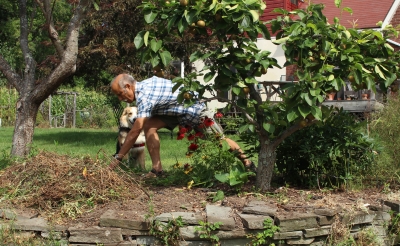
As you might imagine, reaching every weed possible with feet planted in one place calls for all sorts of contortions and stretches forwards, backwards, and sideways involving my legs, trunk, shoulders, arms, and neck. My guess is that after a half-hour of weeding, I’ve run through a close approximation of Utthia Trikonāsana (Triangle Pose), Vīrabhadrāsana (Warrior Pose), and Uttānāsana (Standing Forward Fold Pose), to name a few classic yoga poses — and cleared away weeds!
Weeding (or perhaps, I should write “wee-ding”) is another spa offering.
Ho-ing, to Round Out Exercise Offerings
In addition to hand wee-ding (translation: weeding), in cultivated ground I practice ho-ing with a tool called, of course, a ho. Although the ho (the hoe) originated in Egypt, ho-ing sounds like it comes from China which, historically being a country of small-scale intensive farmers (a “hoe culture”) makes the exercise and the implement seemingly originate in China.
A hoe (American spelling) does good work — if you use the right one in the right manner. The best hoes have a sharp blade that’s easily pushed and/or pulled a mere half-inch or so below ground to kill small weeds. 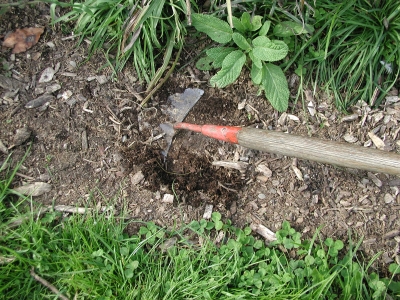 Many types fill the bill, including the scuffle hoe, the stirrup hoe, the colinear hoe, and, my favorites, the wingèd weeder, which looks like an airplane wing sharpened fore and aft, and the wire weeder, whose head is a stiff wire cleverly bent to be easily worked amongst plants.
Many types fill the bill, including the scuffle hoe, the stirrup hoe, the colinear hoe, and, my favorites, the wingèd weeder, which looks like an airplane wing sharpened fore and aft, and the wire weeder, whose head is a stiff wire cleverly bent to be easily worked amongst plants.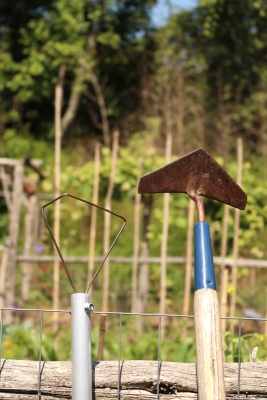
Ideally, I’m out in the garden ho-ing on sunny mornings following rains. The work, if it could be called that, is quick and easy if done before weeds grow large, which would make it a good warm-up or cool-down exercise.
Only when weeds get out of hand is it necessary to get out the tool that most people associate with the word “hoe,” the traditional garden hoe with the large blade at 90 degrees to the handle. This hoe is also the one Charles Dudley Warner was referencing when he stated (in My Summer in a Garden, 1870), “what a [gardener] needs is a cast-iron back, with a hinge in it.
The traditional garden hoe is actually better suited to construction jobs. I reserve mine for mixing kon-krēt in my wheelbarrow.
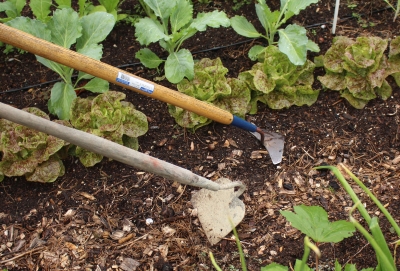
Traditional hoe vs. winged weeder


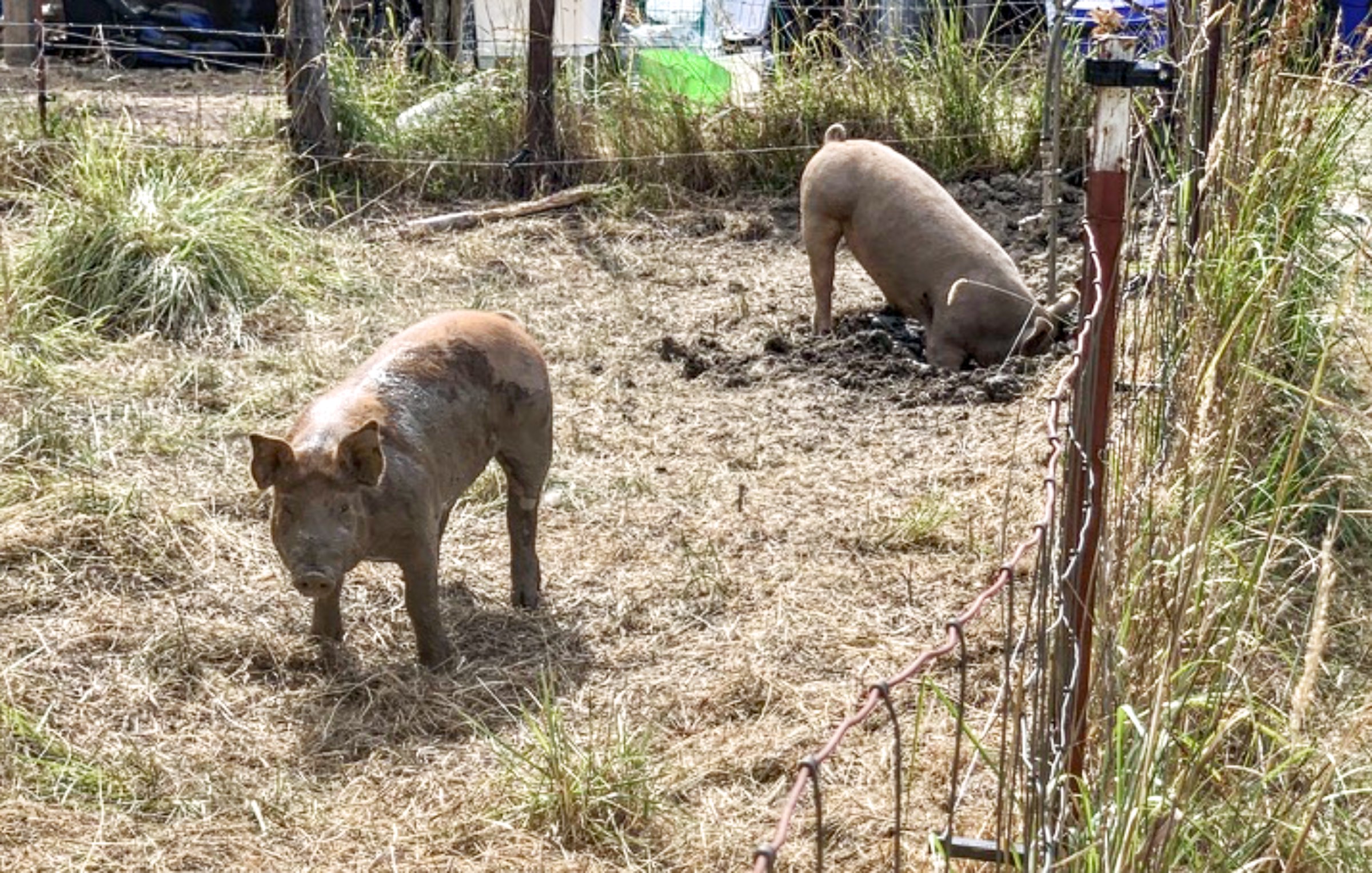
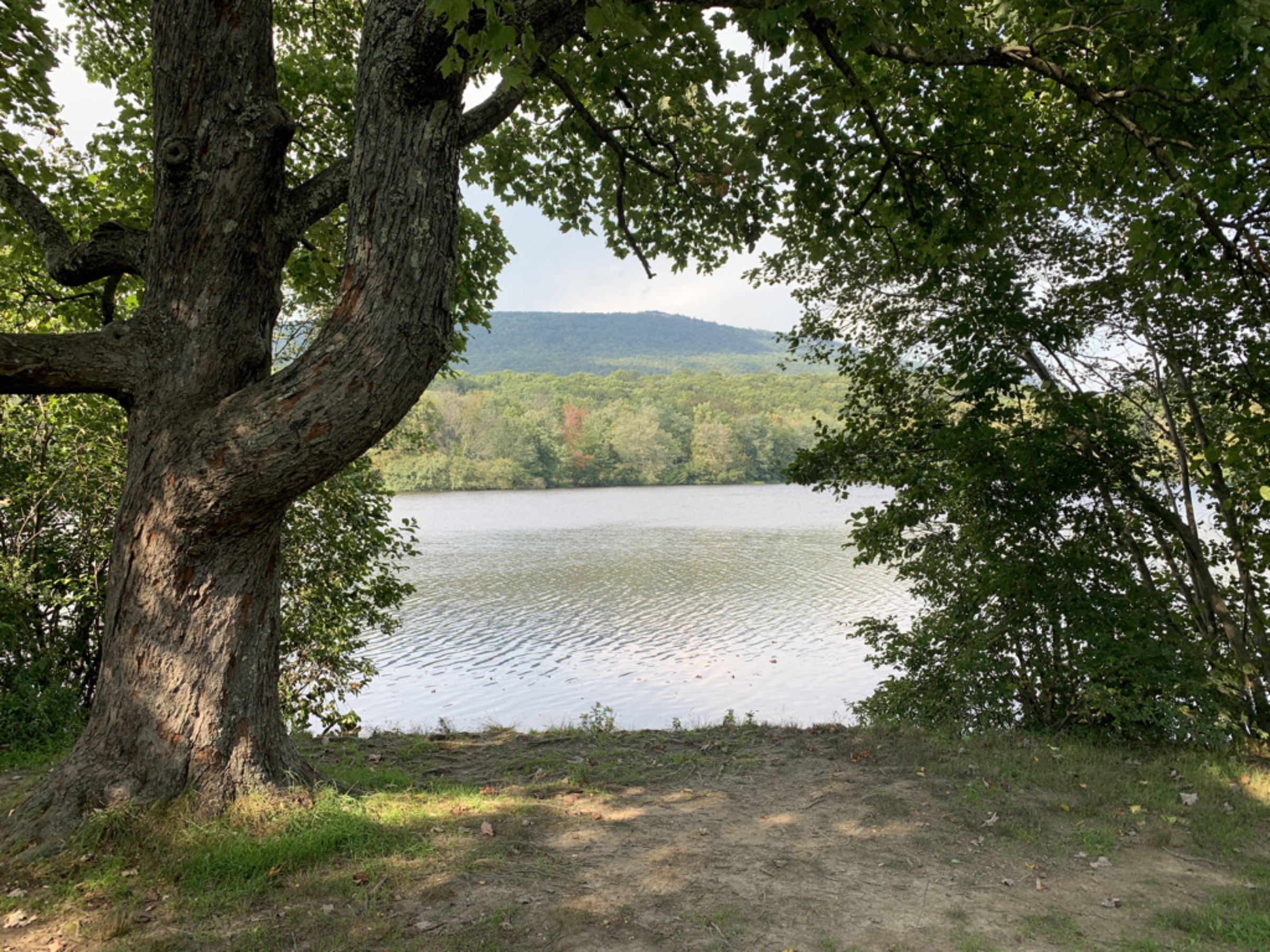
Thank you! Not only have you answered some of my questions, you made me laugh!
Excellent view of staying fit by sustainable gardening techniques. The old tractor seat peddled sharpening water stone keeps a nice edge on the sithes. My other gardening tools which need an edge I tune with a Flat Bastard file. Any other ideas for sharpening?
Keeping an Austrian type scythe blade sharp also entails peening, which is drawing out the metal thinner with a peening hammer and an anvil.
Best ever blog post on the “joys” and benefits of gardening! Thanks so much. Having grown up on a small dairy farm where a lot of the farm crop work was done by hand, I am truly grateful for an early start on healthy care of the land. As kids we picked rock, dug thistles, drove the cattle five miles to summer pasture, pumped water, turned hay, cut corn and bales the oat shocks…all by hand. My father made full use of his eight kids. Since those days, I have always managed somehow to have a garden.
Great to see the joys of hand work in print!
Thank you for that nice comment.
I got intrigued with the idea of getting a scythe after watching a post of yours on composting. I purchased a scythe with a left-handed ditch blade from Scythe Supply (terrific folks) and have really enjoyed using it on tall grass and weeds on the border of my property. I find it to be so much more pleasant and satisfying than using a weed-whacker. In fact, with good technique and regular honing of the blade, I believe it is faster. Thanks!-Bob
I heartily agree with all your points.
Oh, Thanks so much for this! I’ve missed two full weeks (health reasons) in my own little farmden and now I’ll have something to chuckle about as I get caught up.
My “meadows” are inspired by yours, but are simply rock-lined areas throughout my small orchard (a dozen or so trees). I use hedge trimmers to mow them. Hej-jing, I guess. I guess that is a Swedish exercise, or perhaps a bench from IKEA for resting on after the exercise is done.